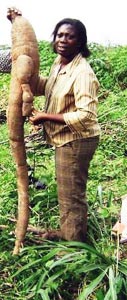East to West: Country perspectives on cassava in Africa
Where we are, and where we could be
East Africa
Download E-publication
Tanzania: on your marks…
Tanzania is Africa’s 4th largest cassava producer, after Nigeria, Ghana and the Democratic Republic of Congo. Second only to maize for food security, cassava covers 670,000 hectares of Tanzania’s farmlands, and annual production stands at seven million tonnes. Three quarters is for human consumption, while a quarter goes to livestock and industrial use, such as starch production.
Despite these impressive figures, productivity is lower than it should be, averaging about 5m tonnes a year, owing to several constraints. Drought and declining soil fertility compromise productivity, and cassava is also vulnerable to several diseases and pests. Diseases are cassava mosaic disease (25 to 100 percent yield loss); cassava brown streak disease (up to 75 percent losses); and cassava bacterial blight, while insect pests are cassava green mites (up to 85 percent yield loss); cassava mealy bugs; and whiteflies, which are also a vector of CMD and CBSD.
GCP supports research in Tanzania through the cassava Community of Practice (CoP) and the cassava Challenge Initiative. The engagement with Tanzania on cassava is not new: A previous project was on phenotyping cassava for drought tolerance in collaboration with EMBRAPA, and included a travel grant to visit the Brazilian partner, as well as equipment to measure soil moisture and leaf conductance. “Cassava varieties developed through GCP funding are currently being evaluated on-station and in farmers’ fields, and five varieties are set for release in 2010 with support from the Alliance for a Green Revolution in Africa (AGRA) for the national performance trials,” reports Dr Geoffrey Mkamilo, a cassava breeder at Tanzania’s Agricultural Research Institute. Tanzania was also one of six countries in a GCP-funded IITA-coordinated project to analyse cassava diversity in Eastern and Central Africa. This work will continue under the CI with a view to generating a cassava reference set.
In addition, while breeding so far has been conventional, time is of the essence in combating disease, and molecular breeding hastens the process. The cassava CI will help with marker validation to determine the viability of the molecular markers. Investigation on CBSD has already commenced, with three mapping populations on the ground and four-month old trials. The next step will be to cross the parents – three susceptible to CBSD and three tolerant to it – and generate the first filial generations (F1), from which to extract DNA to analyse for CBSD marker validation.
 |
Uganda: a race against time
Next door in Uganda, time is also of the essence, underscoring the need for – and advantages of – molecular markers to ensure that research, prevention and mitigation stay ahead of cassava pests and diseases. This is because researchers realise that Uganda and her neighbours need to step up efforts to safeguard East Africa’s precious germplasm from the ravages of CBSD, as well as containment to keep the other regions like West Africa CBSD-free.
“Cassava is the second most important crop for food security after plantains,” reveals Mr Anthony Pariyo, a cassava breeder a Uganda’s National Crop Resources Research Institute (NaCCRI). The two main constraints hampering cassava production in Uganda are both viral – CBSD and CMD. Initially, CMD was the leading constraint, but it has since been overtaken by CBSD. In the race against time, the research paradigm has shifted from conventional breeding approaches alone, to a blend of both conventional and molecular breeding.
In 2005, the National Crop Resources Research Institute (NaCRRI) received CMD- and CGM-resistant germplasm from CIAT facilitated by GCP funding. The germplasm was evaluated, and selection done to constitute parental lines for breeding in Uganda. The material was then crossed, and the progeny is being evaluated on-station. From this exercise, NaCRRI will continue to enrich the gene pool through further crossing, and selected clones will be advanced for on-farm trials. These trials aim for improved culinary quality as the primary consideration, with CGM and CMD resistance as secondary qualities. Ignoring culinary quality may lead to disease-resistant varieties which may be however unpopular with farmers and markets, and are therefore unlikely to be adopted. Through the CoP and other projects, efforts have been initiated in CBSD resistance, including breeder-to-breeder learning with Tanzania, whose researchers have had a longer experience with the disease. Six genotypes from Tanzania are now included in the crossing block to develop CBSD-resistant cassava.
West Africa
Nigeria: Staying ahead and poised for pre-emptive strike
Nigeria is the world’s leading cassava producer and consumer, with 90 percent used for food, of which 70 percent is processed into gari. Annual production averages 45m tonnes on 3.8m hectares. Besides cassava mosaic and other diseases and pests, production is also hampered by inadequate inputs, and by a suboptimal value chain in the link between product and markets, even as Nigeria has the most advanced value chain in Africa.
The National Root Crops Research Institute (NRCRI) and international partners have developed and released 29 varieties so far, with the last two released in 2008. NRCRI hopes to release another five by the end of 2010. One of them is from a GCP-funded CMD project.
Through the CoP, NRCRI is developing genetic stocks with a longer shelf-life in a bid to curb postharvest physiological deterioration (PPD), in addition to high-protein and high-carotene varieties. The marker development work builds on previous GCP investments in cassava. The GSS grant to the CoP has furthered the work on CMD marker development, and a PhD student is working on genotyping for early maturity facilitated by another GSS grant.
In the cassava CI, NRCRI will build on previous results and experience to concentrate (‘pyramiding’ in technical terms) different sources of resistance to the main diseases, especially CMD, through multiple crosses, and to genotype for molecular markers. CBSD work can only be done in East Africa as a validation project for the cassava work funded by the Bill & Melinda Gates Foundation. This validation will be done as soon as markers are ready from the East Africa project.
 “We can then breed pre-emptively for CBSD even before it gains entry into West Africa, with a good level of certainty, even if not 100 percent,” says Dr Chiedozie Egesi (pictured) of NRCRI. And this would not be entirely novel: Nigerian breeders have previously engaged in preventive ‘biological warfare’ by deploying a ‘border patrol brigade’ along the Cameroonian frontier to guard against the East African cassava mosaic virus from Uganda, using cassava varieties that IITA had successfully tested in Uganda. “The time horizon for the CI is rather short, but we will be able to identify markers for validation in other populations, and be able to do marker-assisted selection as a preparatory step towards pre-emptive breeding, using East African material in IITA’s custody,” Dr Egesi observes. “By genotyping with markers in the absence of the pathogen, field trials for CBSD are not necessary. We can also backcross resistant varieties with landraces that carry the desired agronomic traits cherished by farmers and end-users.”
“We can then breed pre-emptively for CBSD even before it gains entry into West Africa, with a good level of certainty, even if not 100 percent,” says Dr Chiedozie Egesi (pictured) of NRCRI. And this would not be entirely novel: Nigerian breeders have previously engaged in preventive ‘biological warfare’ by deploying a ‘border patrol brigade’ along the Cameroonian frontier to guard against the East African cassava mosaic virus from Uganda, using cassava varieties that IITA had successfully tested in Uganda. “The time horizon for the CI is rather short, but we will be able to identify markers for validation in other populations, and be able to do marker-assisted selection as a preparatory step towards pre-emptive breeding, using East African material in IITA’s custody,” Dr Egesi observes. “By genotyping with markers in the absence of the pathogen, field trials for CBSD are not necessary. We can also backcross resistant varieties with landraces that carry the desired agronomic traits cherished by farmers and end-users.”
This approach has been proven in the successful deployment of Latin American germplasm, otherwise susceptible to CMD, into Africa, through GCP projects. Markers alone were used to breed and identify CMD-resistant genotypes at CIAT in the absence of the pathogen, and these were shipped to African partners, with a prediction success rate of over 70 percent. Prior to the GCP projects, it was not possible to ship any Latin American germplasm to Africa because they were all susceptible to CMD.
Ghana: sharing the benefits with the region, and beyond
Cassava is Ghana’s leading food crop, occupying some 750,000 hectares of farmland, and contributing about 22 percent of Ghana’s agricultural GDP. It is the cheapest carbohydrate staple. More than three-quarters of the population (80 percent) rely on cassava as their main carbohydrate staple. Production is estimated at 9.7m tonnes, of which about half is consumed as fufu and the remainder processed into gari or kokonte.
Researchers in Ghana are working to improve yield and resistance to pests and diseases (especially CMD), to enhance desired culinary and industrial qualities, and to give cassava a longer shelf-life by delaying postharvest physiological deterioration (PPD).
GCP’s contribution to cassava research in Ghana has been in developing CMD-resistant varieties; assessing the genetic diversity of Ghanaian landraces; pyramiding useful genes from wild cassava and marker-assisted selection; supporting the establishment of the marker-assisted selection laboratory at Crops Research Institute (CRI); direct and indirect training at all levels, including supporting postgraduate students; and skills in cassava tissue culture multiplication and hardening.
pyramiding useful genes from wild cassava and marker-assisted selection; supporting the establishment of the marker-assisted selection laboratory at Crops Research Institute (CRI); direct and indirect training at all levels, including supporting postgraduate students; and skills in cassava tissue culture multiplication and hardening.
 The ‘seed investment’ in Ghana has blossomed and spread beyond national frontiers. “The biotech lab that was started under the GCP project with funds for its take-off has become a useful lab for university students and scientists from CSIR sister institutes,” says Mrs Elizabeth Parkes of CRI (pictured right). “Presently, nationals from West Africa under the WECARD–CORAF network are undergoing training at the lab. CSIR and other projects have also come on board and supported the lab, which is managed by Dr Mrs Marian Dorcas Quain.” WECARD stands for the West and Central African Council for Agricultural Research and Development (CORAF is its French acronym). “The breeder-to-breeder visits have also brought colleagues from Nigeria and Tanzania to share their experiences, and they too have benefited from the lab,” adds Mrs Parkes.
The ‘seed investment’ in Ghana has blossomed and spread beyond national frontiers. “The biotech lab that was started under the GCP project with funds for its take-off has become a useful lab for university students and scientists from CSIR sister institutes,” says Mrs Elizabeth Parkes of CRI (pictured right). “Presently, nationals from West Africa under the WECARD–CORAF network are undergoing training at the lab. CSIR and other projects have also come on board and supported the lab, which is managed by Dr Mrs Marian Dorcas Quain.” WECARD stands for the West and Central African Council for Agricultural Research and Development (CORAF is its French acronym). “The breeder-to-breeder visits have also brought colleagues from Nigeria and Tanzania to share their experiences, and they too have benefited from the lab,” adds Mrs Parkes.
Links
